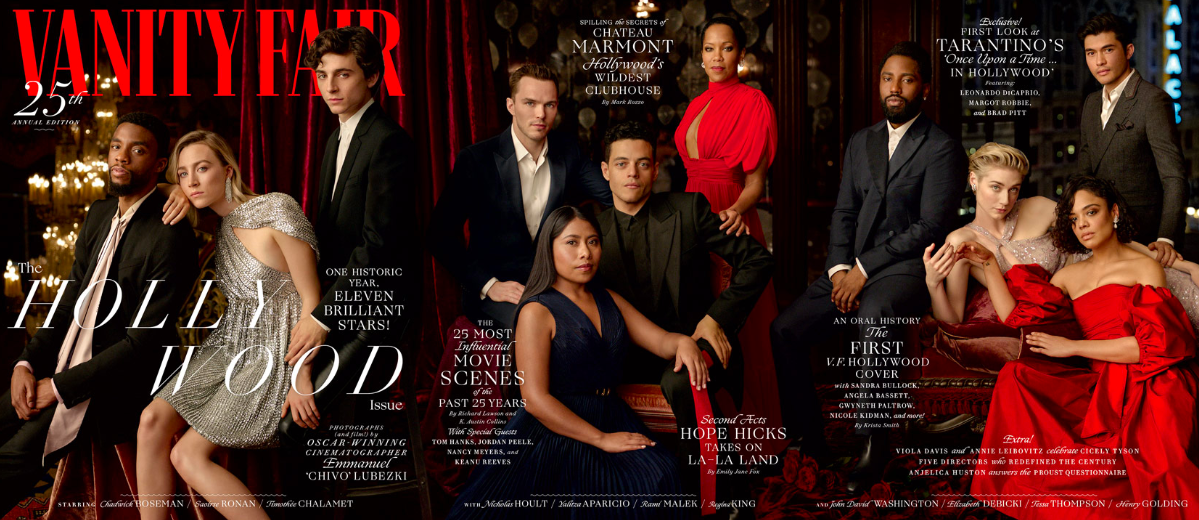
By HILLARY PIZARRO

Vanity Fair’s 2019 Hollywood cover debuted this week and it is full of colors and life, celebrating their 25th issue and rapidly changing times.
Across the spread we see a plethora of races and backgrounds, dressed elegantly as they drape themselves over dimly lit scenes for their “Moving Pictures” campaign directed by three-time Academy Award winner, Emmanuel “Chivo” Lubezki. The picture features many award nominated artists that have caused a stir in the past year. Left to right: Chadwick Boseman, Saoirse Ronan, Timothée Chalamet, Nicholas Hoult, Yalitza Aparicio, Rami Malek, Regina King, John David Washington, Elizabeth Debicki, Tessa Thompson, and Henry Golding.
Viewers were very pleased with the cover and were quick to express their happiness across Twitter. Positive comments showered Vanity Fair’s hashtag, commending them on the diversity as well as the innovation in the cover.
Other comments included some who felt like maybe the issue was still lacking somewhere. Christian Quintana, a 21-year-old movie lover and Marvel fan, said “I don’t know. The cover is beautiful but I feel like it’s missing someone, I just don’t know who.”
Each separate panel is incredible on its own. If this were a film I’d die from just reading the credits. THE DIVERSITY IS SCREAMING and I love it #VFHollywood pic.twitter.com/prNN7TNxBm
— Paige (@_paigegiffon_) January 24, 2019
Publications’ relationships with diversity
This is the magazine’s fifth year releasing an issue with colored actors on its cover, having faced controversy years prior for the ethnic stars placed in the folded pages. This was a running theme for a decade and some change, the only year accounted for being its 2007 cover which featured Chris Rock amongst Ben Stiller, Owen Wilson, and Jack Black.

https://twitter.com/popcornreel/status/1088494317704962048
Misrepresentation is very common not only in magazines but in any company. Vogue is no stranger to this controversy as their favorite model for appropriation and misrepresentation seems to be Kendall Jenner.
She was on their cover for Vogue India’s 10th Anniversary and was also styled with an afro alongside darker skinned model, Imaan Hammam, whose hair was straightened. Imaan has many pictures showing off her naturally curly, ‘fro-like’ locks on her Instagram.
Trinity Head, a 19-year-old undergrad from UCC, has always been interested in topics like this and is extremely verbal with how the media should represent and diversify. “Covers like these are beautiful, they’re real.” She says. “If you want to show you care about your fanbase, you will celebrate color every chance you get.”
How about hiring a black model @voguemagazine? The fashion industry is one of the worst for representation, but insists on using elements of minority cultures. Kendall Jenner should fire her agent- lest we remind her: Pepsi Ad, cover of Vogue India use of Tupac and Biggie’s brand https://t.co/734fY1E8pl
— Eudaimonia Comms (@EudaimoniaCom) October 24, 2018
Hmm….I see no one raging over Kendall’s Vogue Italia…even though she’s not Italian. But the world was raging when she was on Vogue India…. Society cherry picks what they want to be seen as offensive. #KendallJenner #Vogue #VogueItalia #Italy #Proactive #sjw pic.twitter.com/awvxPSrJIH
— Twihtter (@TwihtterHitter) February 3, 2019
Many publications are still struggling with these issues, dominantly white models strewn across each page. According to statistics from McKinsey & Co., companies thrive greatly when they are inclusive both internally and externally.
According to McKinsey & Co., companies with gender and ethnic diversity outperform their competition up to 35 percent. According to SimilarWeb, Vanity Fair’s traffic and popularity are steadily increasing, more than 99 percent of its viewers being purely organic, 52.47 percent of that being from personal searches.